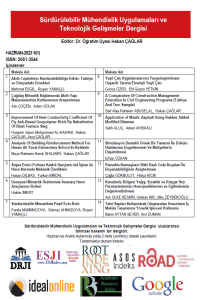Abstract
Researches were made on the use of functional elements for indoor use by using grain stalks and straw. Within the scope of the researches, it was seen that the grain stalks and straw were formed by marketri, plate, block and stacking methods. It is given how the path can be followed according to the desired function. An example is given of which adhesives can be used to create the end product. It is explained what features should be considered when using the adhesives. Interior elements are presented with examples. The form and functions of the final product to be created have been examined. It has been suggested which processes will be experienced in creating these forms. Examples of studies carried out as equivalent are given. Examples are suggested with tables and differences. It has been considered what differences will be brought for use. Due to the hollow structure of the grain stalks, it has been examined which feature replaces the integration into the form. Inferences have been made about how the form can be formed.
References
- C.Cosereanu,C.Cerbu, (2019), “Morphology, Physical, and Mechanical Properties of Particleboard Made from Rape Straw and Wood Particles Glued with Urea-Formaldehyde Resin” Materials Science, Bioresources DOI:10.15376/BIORES.14.2.2903-2918, Corpus ID: 140456550.
- Duman, A. Sıkıştırılmış saman balyalarıyla oluşturulan modüllerden inşa edilen konutların incelenmesi. Mimar Sinan Güzel Sanatlar Üniversitesi Fen Bilimleri Enstitüsü Yüksek Lisans Tezi, sayfa no: 41-42, İstanbul, Türkiye, 2021
- Hasol, D. (1990), Ansiklopedik Mimarlık Sözlüğü, Yem Yayın, İstanbul.
- M.E.B, (2013) Sanat ve Tasarım, “İki parçalı kalıp ve model dökümü”, Ankara, 1-5.
- Rosato, D. V. (1997), “Designing with reinforced composites: Hanser Gardner Publications”.
- Şendemir, E. (1991), ''Formaldehit kullanımı ve zararları'', Uludağ Üniversitesi Tıp Fakültesi Dergisi, 18(2), 361-365.
- url-1: Cordan, Ö. erişim tairihi (2023, 05,12), Yapı Dergisi, https:yapidergisi.com/ic-mekan-atmosferi/ adresinden alındı
- url-2: Olgun, M. (2023, 05,11), İnşaat Malzeme Bilgisi, https://acikders.ankara.edu.tr/pluginfile.php/61361/mod_resource/content/0/imb4.pdf adresinden alındı
Abstract
Tahıl sap ve samanlar kullanılarak iç mekânda kullanıma yönelik işlevsel unsurların kullanımı hakkında araştırılmalar yapılmıştır. Araştırmalar kapsamında tahıl saplarının marketri, plaka, blok ve istifleme yöntemleriyle oluşturulduğu görülmüştür. İstenilen işleve göre nasıl bir yol izlenebileceğine yer verilmiştir. Sonuç ürünü ortaya çıkarma noktasında hangi bağdaştırıcılar kullanılabileceğine örnek verilmiştir. Bağdaştırıcı kullanılırken hangi özelliklere dikkat edilmesi gerektiği açıklanmıştır. İç mekân unsurları örneklerle ortaya koyulmuştur. Oluşturulacak sonuç ürünün hangi form ve işlevlerde kullanılabileceği irdelenmiştir. Bu formları oluşturmada hangi süreçlerin yaşanacağı öne sürülmüştür. Muadil olarak yapılan çalışmalara örnekler verilmiştir. Örnekler tablo ve farklılıklarla öne sürülmüştür. Kullanıma yönelik hangi farklılıklar getirileceği düşünülmüştür. Tahıl saplarının boşluklu yapısı nedeniyle bünyesinde barındığı özelliklerin forma entegrasyonu hangi özelliğe ikame ettiği irdelenmiştir. Formun nasıl oluşabileceği konusunda çıkarımlar yapılmıştır.
References
- C.Cosereanu,C.Cerbu, (2019), “Morphology, Physical, and Mechanical Properties of Particleboard Made from Rape Straw and Wood Particles Glued with Urea-Formaldehyde Resin” Materials Science, Bioresources DOI:10.15376/BIORES.14.2.2903-2918, Corpus ID: 140456550.
- Duman, A. Sıkıştırılmış saman balyalarıyla oluşturulan modüllerden inşa edilen konutların incelenmesi. Mimar Sinan Güzel Sanatlar Üniversitesi Fen Bilimleri Enstitüsü Yüksek Lisans Tezi, sayfa no: 41-42, İstanbul, Türkiye, 2021
- Hasol, D. (1990), Ansiklopedik Mimarlık Sözlüğü, Yem Yayın, İstanbul.
- M.E.B, (2013) Sanat ve Tasarım, “İki parçalı kalıp ve model dökümü”, Ankara, 1-5.
- Rosato, D. V. (1997), “Designing with reinforced composites: Hanser Gardner Publications”.
- Şendemir, E. (1991), ''Formaldehit kullanımı ve zararları'', Uludağ Üniversitesi Tıp Fakültesi Dergisi, 18(2), 361-365.
- url-1: Cordan, Ö. erişim tairihi (2023, 05,12), Yapı Dergisi, https:yapidergisi.com/ic-mekan-atmosferi/ adresinden alındı
- url-2: Olgun, M. (2023, 05,11), İnşaat Malzeme Bilgisi, https://acikders.ankara.edu.tr/pluginfile.php/61361/mod_resource/content/0/imb4.pdf adresinden alındı
Details
| Primary Language | Turkish |
|---|---|
| Subjects | Architecture |
| Journal Section | Articles |
| Authors | |
| Early Pub Date | May 28, 2023 |
| Publication Date | June 25, 2023 |
| Submission Date | March 6, 2023 |
| Acceptance Date | May 28, 2023 |
| Published in Issue | Year 2023 Volume: 6 Issue: 1 |
Creative Commons Lisansı
Bu eser Creative Commons Atıf 4.0 Uluslararası Lisansı ile lisanslanmıştır.


